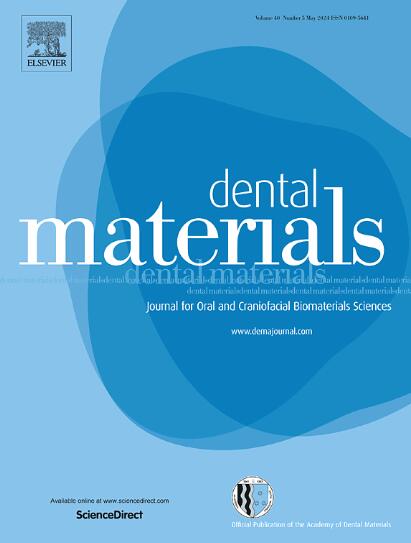The effect of photoinitiator systems on resin-based composite containing ZnO-nanoparticles
IF 4.6
1区 医学
Q1 DENTISTRY, ORAL SURGERY & MEDICINE
引用次数: 0
Abstract
Objective
Zinc oxide (ZnO) powder possesses antibacterial activity and although white in color, it can severely reduce the depth of cure (DoC) of resin-based composite (RBC). This study investigated the effect of unary and binary photoinitiator systems on the DoC and degree of conversion (DC) of formulated RBC containing ZnO-nanoparticles.
Methods
Fourteen RBCs (n = 3/group) were formulated consisting of 50 wt% mixture of monomers (Bis-GMA, TEGDMA, and UDMA) and 50 wt% fillers (inert barium glass powder and silica nanoparticles). ZnO-nanoparticles were added at 0 (control), 0.5, 1, 1.5 and 2 wt%. A unary initiator system consists of camphorquinone (CQ) 0.25, 0.5 and 1 wt% and ethyl 4-(dimethylamino)benzoate (EDMAB) 0.75 wt% or a binary initiator system consisting of diphenyliodonium hexafluorophosphate (DPI) 0.25, 0.5 and 1 wt%, CQ 0.25, 0.5 and 1 wt% and EDMAB 0.75 wt% were added to the monomer mixture. To measure the DoC, each specimen was prepared in a custom-made mold with a slot (16 x 8×2 mm) and a top cover plate, irradiated from one end (40 s), stored dry (37° C, 1 d) and measured at increasing depths using Vickers hardness (0.5 mm intervals). 1 mm thick specimens were prepared to measure DC continuously using FTIR, from zero up to 24 h post-irradiation.
Results
Increasing the concentrations of ZnO led to a significant reduction of DoC (p < 0.05). But most of the binary initiator groups showed significantly higher DoC (p < 0.05). Depth, at 80 % of max VHN, of unary initiator groups reduced from 6.8 mm (ZnO at 0 wt%) to 2.1 mm (ZnO at 2 wt%) and in binary initiator groups from 8.4 mm to 2.3 mm. Groups with lower photoinitiator concentrations (0.25 wt%) showed a significant increase in DoC compared with groups with higher concentrations (1 wt%) (p < 0.05). DC after 24 h was independent of either ZnO concentration or the photoinitiator system (p > 0.05). However, faster conversions were observed in binary initiator groups. The RPmax of binary groups ranged from 8.1 % to 10.1 %/s, and unary groups ranged from 5.2 % to 7.2 %/s.
Significance
The addition of DPI resulted in an overall increased curing depth, which was enhanced when lower concentrations of photoinitiators were used. Also, DPI resulted in faster conversions. This is desirable in designing antibacterial RBC containing ZnO.
光引发剂体系对含zno纳米颗粒树脂基复合材料的影响。
目的:氧化锌(ZnO)粉末具有抗菌活性,虽然呈白色,但会严重降低树脂基复合材料(RBC)的固化深度(DoC)。研究了一元和二元光引发剂体系对含zno纳米颗粒的配方红细胞的DoC和转化率(DC)的影响。方法:14个红细胞(n = 3/组)由50 wt%的单体(Bis-GMA、TEGDMA和UDMA)和50 wt%的填料(惰性钡玻璃粉和二氧化硅纳米颗粒)组成。分别在0(对照)、0.5、1、1.5和2 wt%的浓度下添加zno纳米颗粒。在单体混合物中加入由脑醌(CQ) 0.25、0.5和1 wt%和4-(二甲氨基)苯甲酸乙酯(EDMAB) 0.75 wt%组成的一元引发剂体系或由六氟磷酸二苯硫鎓(DPI) 0.25、0.5和1 wt%, CQ 0.25、0.5和1 wt%和EDMAB 0.75 wt%组成的二元引发剂体系。为了测量DoC,每个样品在一个定制的模具中制备,模具上有一个槽(16 x 8×2 mm)和一个顶盖板,从一端照射(40 s),干燥储存(37°C, 1 d),并使用维氏硬度(0.5 mm间隔)在增加的深度进行测量。制备1 mm厚的样品,用FTIR连续测量DC,从零到24 h辐照后。结果:增加氧化锌浓度可显著降低DoC (p 0.05)。然而,在二元引发剂组中观察到更快的转换。二组RPmax为8.1 % ~ 10.1 %/s,一组RPmax为5.2 % ~ 7.2 %/s。意义:DPI的加入导致固化深度总体增加,当使用较低浓度的光引发剂时,固化深度得到增强。此外,DPI还带来了更快的转换。这是设计含ZnO的抗菌红细胞所需要的。
本文章由计算机程序翻译,如有差异,请以英文原文为准。
求助全文
约1分钟内获得全文
求助全文
来源期刊

Dental Materials
工程技术-材料科学:生物材料
CiteScore
9.80
自引率
10.00%
发文量
290
审稿时长
67 days
期刊介绍:
Dental Materials publishes original research, review articles, and short communications.
Academy of Dental Materials members click here to register for free access to Dental Materials online.
The principal aim of Dental Materials is to promote rapid communication of scientific information between academia, industry, and the dental practitioner. Original Manuscripts on clinical and laboratory research of basic and applied character which focus on the properties or performance of dental materials or the reaction of host tissues to materials are given priority publication. Other acceptable topics include application technology in clinical dentistry and dental laboratory technology.
Comprehensive reviews and editorial commentaries on pertinent subjects will be considered.
 求助内容:
求助内容: 应助结果提醒方式:
应助结果提醒方式:


